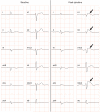Drugs and Brugada syndrome patients: review of the literature, recommendations, and an up-to-date website (www.brugadadrugs.org)
- PMID: 19716089
- PMCID: PMC2779019
- DOI: 10.1016/j.hrthm.2009.07.002
Drugs and Brugada syndrome patients: review of the literature, recommendations, and an up-to-date website (www.brugadadrugs.org)
Abstract
Background: Worldwide, the Brugada syndrome has been recognized as an important cause of sudden cardiac death in individuals at a relatively young age. Importantly, many drugs have been reported to induce the characteristic Brugada syndrome-linked ECG abnormalities and/or (fatal) ventricular tachyarrhythmias.
Objective: The purpose of this study was to review the literature on the use of drugs in Brugada syndrome patients, to make recommendations based on the literature and on expert opinion regarding drug safety, and to ensure worldwide online and up-to-date availability of this information to all physicians who treat Brugada syndrome patients.
Methods: We performed an extensive review of the literature, formed an international expert panel to produce a consensus recommendation to each drug, and initiated a website (www.brugadadrugs.org).
Results: The literature search yielded 506 reports for consideration. Drugs were categorized into one of four categories: (1) drugs to be avoided (n = 18); (2) drugs preferably avoided (n = 23); (3) antiarrhythmic drugs (n = 4); and (4) diagnostic drugs (n = 4). Level of evidence for most associations was C (only consensus opinion of experts, case studies, or standard-of-care) as there are no randomized studies and few nonrandomized studies in Brugada syndrome patients.
Conclusion: Many drugs have been associated with adverse events in Brugada syndrome patients. We have initiated a website (www.brugadadrugs.org) to ensure worldwide availability of information on safe drug use in Brugada syndrome patients.
Figures



Comment in
-
The acquired Brugada syndrome and the paradox of choice.Heart Rhythm. 2009 Sep;6(9):1342-4. doi: 10.1016/j.hrthm.2009.07.033. Epub 2009 Jul 21. Heart Rhythm. 2009. PMID: 19716090 Free PMC article. No abstract available.
References
-
- Antzelevitch C, Brugada P, Borggrefe M, et al. Brugada syndrome: report of the second consensus conference. Heart Rhythm. 2005;2:429–440. - PubMed
-
- Wilde AA, Antzelevitch C, Borggrefe M, et al. Proposed diagnostic criteria for the Brugada syndrome: consensus report. Circulation. 2002;106:2514–2519. - PubMed
-
- Gehi AK, Duong TD, Metz LD, Gomes JA, Mehta D. Risk stratification of individuals with the Brugada electrocardiogram: a meta-analysis. J Cardiovasc Electrophysiol. 2006;17:577–583. - PubMed
-
- Paul M, Gerss J, Schulze-Bahr E, et al. Role of programmed ventricular stimulation in patients with Brugada syndrome: a meta-analysis of worldwide published data. Eur Heart J. 2007;28:2126–2133. - PubMed
-
- Eckardt L, Probst V, Smits JP, et al. Long-term prognosis of individuals with right precordial ST-segment-elevation Brugada syndrome. Circulation. 2005;111:257–263. - PubMed
Publication types
MeSH terms
Substances
Grants and funding
LinkOut - more resources
Full Text Sources
Medical

